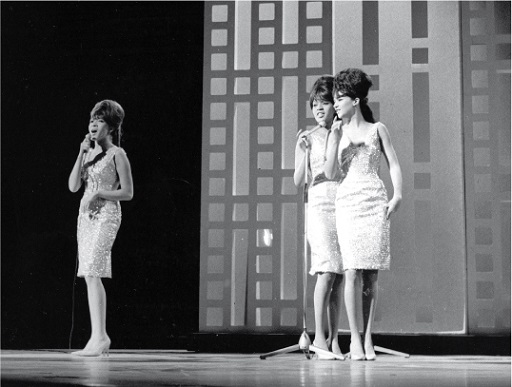2 Verses and choruses
The opening of ‘Be My Baby’ (1963) by The Ronettes features a particularly clear alternation between contrasting verses and choruses.
Activity 1
Listen at least twice to the first 01:37 of ‘Be My Baby’ while following along with Table 1, which outlines the alternation of verses and choruses by means of track timings and lyrics. Pay attention to how both the lyrics and the musical material recur from the first to the second chorus. Notice, too, how, although Verse 1 and Verse 2 have different lyrics, they are musically similar. (Verse 1 is preceded by a short instrumental introduction, one of the most widely imitated openings in pop music.)
| Section | Track time | Lyrics |
|---|---|---|
Introduction
|
00:00 | — |
| Verse 1 | 00:07 | The night we met I knew I needed you so, And if I had the chance, I’d never let you go So won’t you say you love me; I’ll make you so proud of me; We’ll make ’em turn their heads every place we go.
|
| Chorus | 00:35 | So won’t you please (be my, be my baby) be my little baby (my one and only baby), Say you’ll be my darling (be my, be my baby), be my baby now (my one and only baby), a-whoa-oh-oh-oh.
|
| Verse 2 | 00:52 | I’ll make you happy, baby, just wait and see; For every kiss you give me, I’ll give you three. Oh, since the day I saw you, I have been waiting for you; You know I will adore you till eternity.
|
| Chorus | 01:20 | So won’t you please (be my, be my baby) be my little baby (my one and only baby), Say you’ll be my darling (be my, be my baby), be my baby now (my one and only baby), a-whoa-oh-oh-oh oh.
|
In listening, you may have observed some subtle musical differences between the two verses or the two choruses. The backup singers have a more prominent role in Verse 2 than in Verse 1; tougher to spot is that the second chorus has one more ‘oh’ than the first! It’s because of such differences that relationships between components are described in Section 1 as ‘the same or very similar’. Again, musical repetition and variation exist on a spectrum: even straightforward repetitions frequently contain some variation.
‘Be My Baby’ highlights a typical distinction between verses and choruses: verses tend to be text-centred and narrative-focused; choruses tend to be music-centred and expression-focused. It is no accident that the chorus of ‘Be My Baby’ features considerable repetition of words, and that by the end of it, the words have been replaced by vocables (sung, meaningless syllables): the music has established priority over the text. Related to this is that choruses also tend to contain a song’s most memorable and engaging musical material. In the chorus of ‘Be My Baby’, the overlapping exchanges between the lead and backup singers and the use of simple, repeated texts seem to invite listeners to sing along. The point of a pop chorus such as this one is to get you to remember it.

